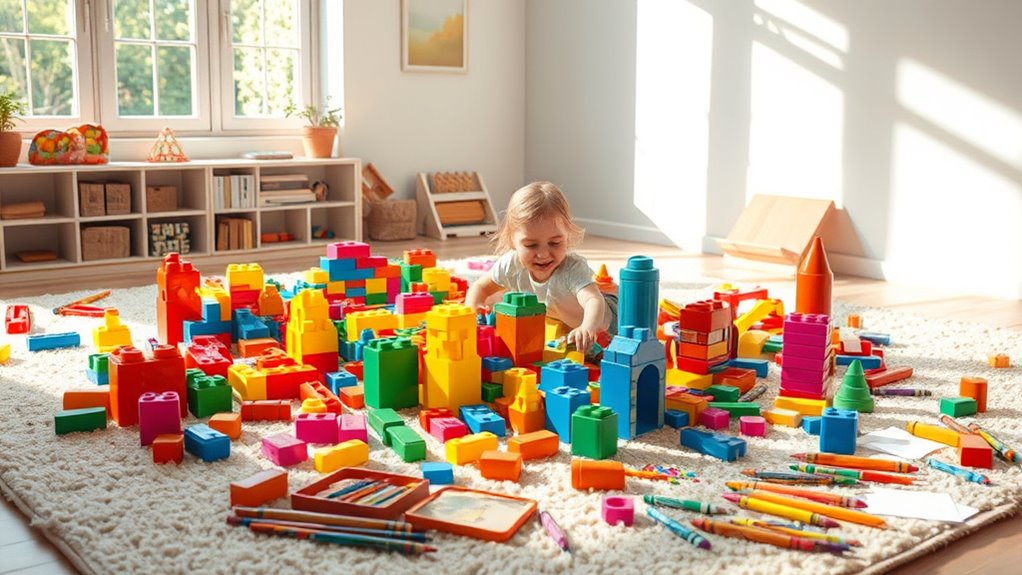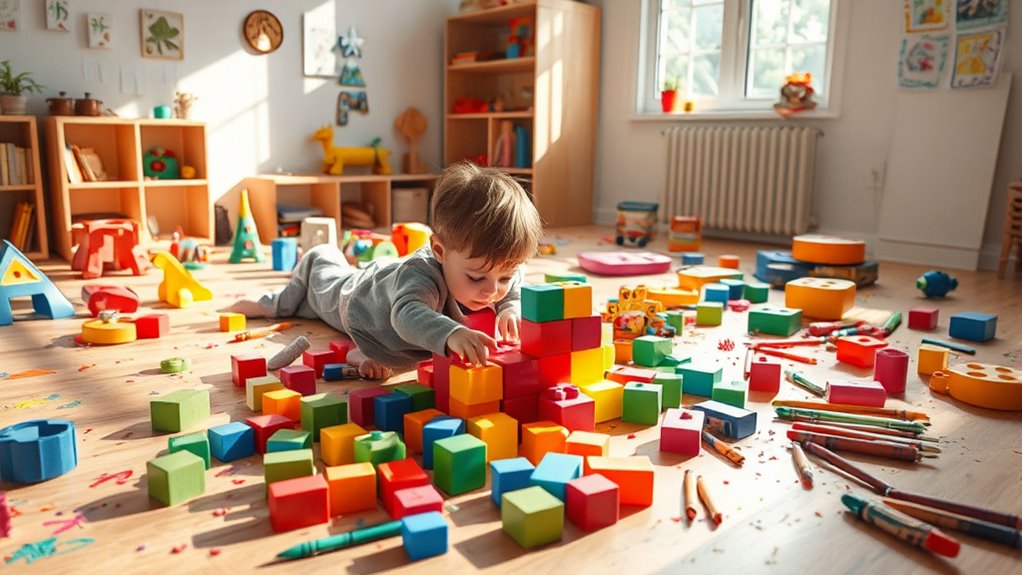Encouraging independent play is essential for sparking your child’s creativity. By providing open-ended toys and materials, you give them the freedom to explore their imaginations. Set up a safe environment where they feel ownership over their activities, and gradually increase their playtime. Positive reinforcement for their efforts boosts confidence and fosters a love for exploration. As they engage in different themes and interests, you’ll see their creativity flourish—stay tuned to discover more ways to enhance their play experience!
Key Takeaways
- Provide a variety of open-ended toys and materials to inspire imaginative play and creativity.
- Create a safe environment where children feel free to explore and make choices.
- Gradually increase time intervals for independent play to build confidence and decision-making skills.
- Encourage exploration of personal interests with themed resources and educational tools.
- Celebrate achievements and efforts with positive reinforcement to boost self-esteem and motivation.

How can you foster a sense of independence in your child through play? By encouraging independent play, you’re not only allowing your child to explore their creativity but also helping them build essential skills that will serve them throughout life. When you give your child the space to play on their own, you invite them to engage in problem-solving, critical thinking, and self-expression. It’s all about creating an environment where they feel confident to venture out and discover their interests.
Start by providing a variety of open-ended toys and materials. Think blocks, art supplies, or even costumes for imaginative play. These items allow your child to create their own narratives and structures without predefined rules. When they have options, they’ll learn to make choices and develop decision-making skills, which are vital for independence. You don’t need to direct their play; let them take the reins. This way, they’ll feel a sense of ownership over their activities.
Provide open-ended toys to inspire creativity and decision-making, allowing your child to take ownership of their play.
Next, set aside specific times for independent play. You can start with short intervals, gradually increasing the time as your child becomes more comfortable playing alone. During this time, resist the urge to intervene or interrupt. Instead, observe from a distance. This not only reassures them that you’re nearby but also gives them the freedom to navigate their play experiences without constant oversight. Your presence can be a safety net, allowing them to explore without fear of failure.
Encourage them to try new things and explore their interests. If they show a fascination with a particular subject, like dinosaurs or art, provide resources related to those themes. This can spark their creativity and motivate them to engage in independent projects. When they’re excited about what they’re doing, they’ll naturally explore more deeply, discovering new facets of their interests. Providing educational toys can also enhance their learning experience during independent play.
Lastly, celebrate their achievements, no matter how small. When you acknowledge their creativity and efforts, you reinforce their confidence and encourage them to keep exploring. A simple phrase like “I love how you built that tower!” can go a long way in boosting their self-esteem.
In fostering a sense of independence through play, you’re not just giving your child time to entertain themselves; you’re helping them cultivate skills that will enrich their lives. Trust in their ability to explore, and watch as they blossom into confident, creative individuals.
Frequently Asked Questions
What Age Is Best to Start Encouraging Independent Play?
You can start encouraging independent play as early as 2 years old. At this age, kids are naturally curious and enthusiastic to explore their surroundings. Provide safe spaces and engaging toys to spark their imagination. As they grow, gradually give them more freedom to play alone. This helps build their confidence and creativity. Remember, every child is different, so pay attention to their cues and interests to find the right balance for them.
How Can I Balance Independent Play With Structured Activities?
To balance independent play with structured activities, think of it like a dance. You let your child lead during free play, while you gently guide them with structured tasks. For instance, set aside specific times for both, maybe an hour for creative exploration followed by a short, engaging activity. This way, you create a rhythm that allows space for imagination and learning, ensuring your child thrives in both environments.
Are There Specific Toys That Promote Independent Play?
Yes, certain toys definitely promote independent play. Consider open-ended toys like building blocks, art supplies, and dolls or action figures. These encourage creativity and self-directed play. Puzzles and simple board games also allow for solo play while developing problem-solving skills. Additionally, sensory bins filled with various materials can spark exploration. Look for toys that let you use your imagination and that don’t come with strict rules, so you can play freely.
How Do I Handle My Child’s Reluctance to Play Alone?
When your child’s like a bird hesitant to leave the nest, start by creating a cozy play environment. Introduce simple activities that spark their interest, and gradually encourage solo exploration. You can offer gentle reassurance, letting them know it’s okay to play alone. Set a timer for short intervals and celebrate their achievements. Over time, their confidence will blossom, and they’ll discover the joy of adventure in their own imaginative world.
What Are the Long-Term Benefits of Independent Play?
Independent play fosters essential skills in your child, like creativity, problem-solving, and self-reliance. When they engage alone, they explore their imagination and learn to entertain themselves, which builds confidence. Over time, this practice enhances their social skills as they learn to navigate interactions more independently. You’ll notice they become more resilient, adaptable, and capable of handling challenges on their own, laying a strong foundation for future learning and personal growth.
Conclusion
In the garden of childhood, independent play is the sun that helps creativity bloom. Just as flowers thrive when given space to stretch, children flourish when allowed to explore on their own. So, let them wander through their imaginative landscapes, crafting stories and adventures like bees gathering nectar. Trust that these moments of solitude will yield a vibrant bouquet of skills and confidence, nurturing their minds for years to come. Embrace the magic of their solo journeys!









